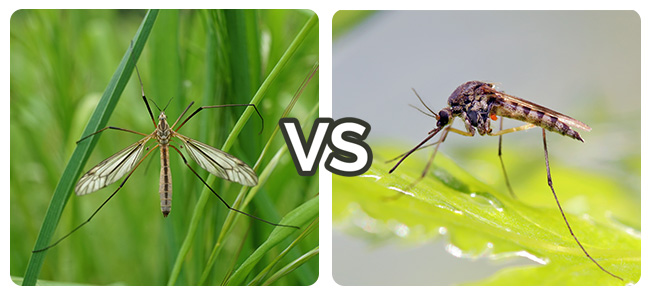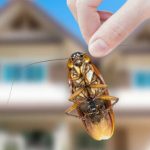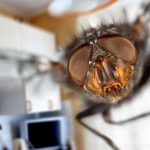
Due to their similar physical features, people tend to mix up craneflies with mosquitoes. Significantly larger craneflies can seem intimidating, but they are not as scary as our imagination depicts. Craneflies are not harmful to people; however, they can affect the health of your lawn.
In this post, we’ll explain how to differentiate craneflies from mosquitoes and, based on that, find a proper solution to your problem. So, if you:
- Have noticed mosquito-like insects in your house;
- Can’t identify which kind of insect infestation you are dealing with;
- Wish to know how to deal with a cranefly or mosquito infestation;
Then keep on reading!
What are the similarities between crane flies and mosquitoes?
The biggest and most noticeable similarity between craneflies and mosquitoes is their appearance. No wonder crane flies are commonly mistaken for large mosquitoes. These flying insects have extremely long legs, elongated faces that are often mistaken for proboscis, and widely spread wings. Unless you have both types of insects in front of you, it’s easy to assume that a large mosquito has gotten into your house.
Just like mosquitos, crane flies can sometimes lay eggs next to water sources. They choose undisturbed water surfaces, so their larvae can be safe there and have all the important nutrients to consume for healthy development.
What is the difference between a crane fly and a mosquito?
Despite the small resemblance in appearances and sometimes habitat, mosquitoes and crane flies have anything in common barely. If you look closer at the anatomy of a cranefly, you will notice that it has a prolonged body with slender legs. Craneflies have straight bodies, whereas mosquitoes have bent thorax and abdomen. However, the biggest difference between the two is the size – craneflies can grow up to 8 cm long, and a mosquito is usually small, about 0.5-1.5 cm long.
Their infestation patterns are also quite different. Even though both of the insects infest outdoor spaces, they choose their breeding grounds differently. Mosquitoes lay eggs in water because the larvae will later feed on the microorganisms in them. Cranefly larvae, also called leatherjackets, live off plant roots, grasses, and algae. This is why they can be found on your lawn and sometimes next to bodies of water.
Another significant difference between craneflies and mosquitoes is that craneflies do not bite. If you see one in your house, the light most likely attracts it and stuck inside. Conversely, mosquitoes can choose your house as a breeding ground if they find an open-water source and will feed on you.
Crane fly identification
Now that you know the similarities and differences between mosquitoes and craneflies, let’s look at each of them individually.
What is a crane fly?
Crane fly is the common name for any insect of the Tipulidae family. This thumb-sized flying insect has a slender body, long legs, and smoke-coloured wings. The prolonged body makes it an extremely clumsy flier, which is why their flying looks more like wobbling. A cranefly is also known as a daddy longlegs fly.
When do craneflies emerge?
In the UK, adult craneflies emerge from late summer until mid-autumn. For 10 to 15 days of a crane fly’s life, its sole purpose is to find a mating partner and lay eggs in a moist vegetative habitat. Shortly after, the eggs will hatch, and the off-white larvae will start feeding. The leatherjacket larvae remain in the soil throughout the winter or until they are fully grown to pupate. In 2-3 weeks of pupating, the new “batch” of crane flies is ready to reproduce.
What do crane flies eat?
The majority of the feeding happens during their larval stage. They eat plant roots, decaying leaves, and other organic matter in the soil. The adult species occasionally feed on nectar.
What are crane flies attracted to?
Often, we notice crane flies when we hear them banging on a ceiling around a light source. It happens because adult insects are nocturnal and attracted to light. On the other hand, the larvae live underground and search for roots, leaves, and grass to feed on during their development.
Are crane flies harmful?
Craneflies don’t bite people or animals; therefore, they can not transfer diseases and harm people’s health like mosquitoes. However, the larvae of these flies are considered pests and can damage your lawn. The lawn can turn yellow and develop brown patches.
How to get rid of crane flies
You might try to kill crane flies with a bug zapper or even a sandal. However, it may not make any difference because this will not end the problem. That said, here is how to handle the situation properly:
- Identification
The first thing that you need to do is make sure that you are dealing with crane flies.
- Lawn examination
If you suspect that you have larvae infesting your lawn, look for birds pecking the grass. They will leave a lot of small holes in an attempt to pull out the worms. Also, your lawn might start looking patchy closer to spring, as this is the time when leatherjackets feed more actively.
- Control
The best way to control the crane fly infestation is by exterminating the insects during the larval stage. Nematodes are the natural and most effective way of killing leatherjackets. All you need to do is add them to the moist lawn during spring or autumn when the weather is not hot.
- Prevention.
You must keep your lawn healthy to ensure that the leatherjackets will not come back the next season. Check if your garden drains well, mow your lawn regularly, and remove debris from your yard. And if you struggle to find time to maintain your garden, you can always book a professional garden maintenance service.
Mosquito identification
We’ve all been bitten by a mosquito at least once. But do we really know why they need our blood? Well, let’s find out.
What is a mosquito?
Just like craneflies, mosquitoes have thin bodies and long legs but are significantly smaller. Using the antennae on top of their head, these insects can sense the carbon dioxide that people and animals breathe out and the movement of the air. Female mosquitoes use a proboscis, an elongated part of the month, to suck out blood. Both males and females have it. However, the male’s proboscis is too weak to pierce through the skin, so they use it for drinking nectar, making them good pollinators.
Mosquitoes are also quite good at flying. Their wings and high sensitivity allow them to move fast and avoid obstacles.
Are there mosquitoes in the UK?
The short answer is yes – there are mosquitoes in the UK. In fact, the UK is home to 34 native mosquito species. Luckily, there are no vector mosquitoes (those that spread pathogens), so you shouldn’t worry much if you get bitten.
When do mosquitoes emerge?
Mosquitoes are seasonal pests and are mainly associated with summer. However, they can start being active as early as April and continue terrorising the population until September. During this period, female mosquitoes will lay eggs. Once they are ready, they will search for an undisturbed water surface. One female can lay up to 200 eggs. Eggs will hatch within several weeks, and larvae will develop in water sources. In the next stage, the larvae will pupate, still underwater, and adult mosquitoes will emerge soon after that.
What do mosquitoes eat?
Mosquito larvae feed on bacteria, algae, and other microorganisms in water. Pupae remain still and undergo a transformation process for several days. Therefore, they don’t eat at all. Adult mosquitoes’ diet includes not only blood but also flower nectar. This fact is overlooked by many, as we often see mosquitoes only when they decide to hunt us.
Unfortunately, their passion for blood turns some of them into dangerous transmitters of harmful and even fatal diseases. Malaria, dengue fever, and yellow fever are some of the many others. Vector mosquitoes (those that transmit diseases) often thrive in hot and humid climate conditions.
What attracts mosquitoes?
The way mosquitoes choose their prey is quite fascinating. Several criteria make you more susceptible to mosquito bites. They include:
- Clothing – Mosquitoes see dark and bold colours the best. Colours, such as red, black, and navy blue, can easily attract them;
- Smell – These insects are drawn to smells. Not only sweet perfumes and deodorants attract mosquitoes, but any type of human odour (sweat, for example) allows them to recognise and locate you;
- Exercising – Mosquitoes are attracted to the carbon dioxide we exhale. When we exercise, we produce more carbon dioxide as breathing becomes faster. Additionally, sweating can also attract these insects;
- Body temperature – The higher your body temperature, the more chances you have to get bitten;
- Blood type – Mosquitoes are more interested in people with type 0 blood.
How can I avoid getting bitten by a mosquito?
There are several proven ways to prevent mosquito bites:
- Dispose of any standing water
Mosquitoes breed in stagnant water. A flowerpot, uncleaned gutter, or dog bowl can be a perfect breeding ground for mosquitoes.
- Don’t let them into your house
Installing a mosquito screen on your windows or doors can prevent mosquitoes from entering your house.
- Use repellents
Different brands of mosquito repellents are available in shops and vary in concentration and active ingredients. If you spend a lot of time outdoors, search for the ones with the higher concentration. Check the instructions to find out how often you need to use it. Effective repellents should contain DEET (diethyltoluamide), Icaridin (Picardin), Lemon Eucalyptus (PMD), or IR3535.
- Make yourself less appealing to mosquitoes
Try to avoid dark clothing or floral perfumes. Consider wearing loose-fitting clothes, as mosquitoes can bite through clothing that fits tightly. Long sleeves, high necklines, long trousers, and skirts can save you from nasty mosquito bites.
- Air-conditioning and ventilators
Mosquitoes avoid entering properties with constant air-conditioning. Because they are cold-blooded, they seek warmer places. Turning on air-conditioning can suppress the mosquito activity in your house.
If you have an outdoor mosquito problem, we suggest checking out our “How to Repel Mosquitoes In Your Garden” guide. It breaks down all the internet myths about mosquito repelling techniques and how effective they are.
Have trouble with small flying insects in your house?
Sometimes DIY methods can be useless against mosquitoes. Even if you manage to get rid of adult species, mosquitoes lay many eggs in just 2 weeks. A lack of professional equipment and pest extermination knowledge can turn a small infestation into a recurring problem. Don’t spend your time and nerves on something that is out of your control – get a professional fogging treatment instead!
Fogging is a pest extermination method that uses a special ULV fogger to spread a powerful insecticide in your house. All you need to do is share the problematic areas in your house with the pest controllers, and they will handle the job afterwards. This method is also perfectly suitable for other pests like moths, flies, ants, and even wasps. So, what are you waiting for? Book your fogging treatment with Fantastic Services today!
Need a professional treatment?
Find a pest controller to take care of it.

Takeaways
- Even though both mosquitoes and craneflies have slender legs, spread wings, and prolonged faces, they are quite different
- Mosquitoes can live indoors and outdoors next to open water sources, whereas craneflies prefer outdoor living and lay their eggs in the lawn;
- Craneflies do not bite people, therefore, don’t transfer diseases, as mosquitoes do. However, they are still considered pests because of the damage that their larvae can inflict on your lawn;
- To avoid a leatherjacket infestation, keep your lawn tidy and well-maintained;
- Mosquito bites can be avoided by limiting standing water, using mosquito repellent, and wearing light and wide clothes.
***
Did you find this post useful? Share your thoughts in the comments down below!

